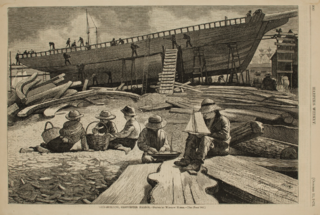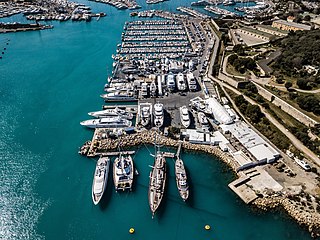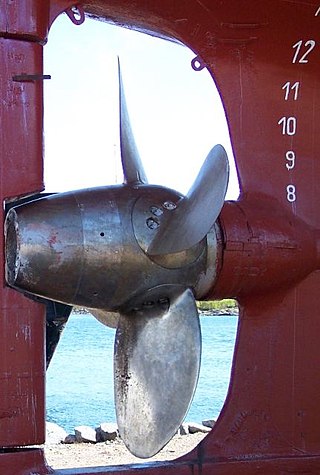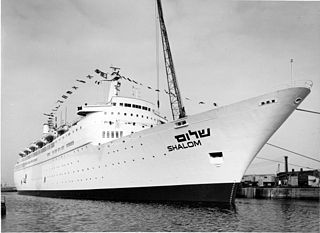
A ship is a large vessel that travels the world's oceans and other navigable waterways, carrying cargo or passengers, or in support of specialized missions, such as defense, research and fishing. Ships are generally distinguished from boats, based on size, shape, load capacity and purpose. Ships have supported exploration, trade, warfare, migration, colonization, and science. Ship transport is responsible for the largest portion of world commerce.

Shipbuilding is the construction of ships and other floating vessels. It normally takes place in a specialized facility known as a shipyard. Shipbuilders, also called shipwrights, follow a specialized occupation that traces its roots to before recorded history.

A shipyard, also called a dockyard or boatyard, is a place where ships are built and repaired. These can be yachts, military vessels, cruise liners or other cargo or passenger ships. Compared to shipyards, which are sometimes more involved with original construction, dockyards are sometimes more linked with maintenance and basing activities. The terms are routinely used interchangeably, in part because the evolution of dockyards and shipyards has often caused them to change or merge roles.

USS Long Beach (CLGN-160/CGN-160/CGN-9) was a nuclear-powered guided missile cruiser in the United States Navy and the world's first nuclear-powered surface combatant. She was the third Navy ship named after the city of Long Beach, California.

A merchant ship, merchant vessel, trading vessel, or merchantman is a watercraft that transports cargo or carries passengers for hire. This is in contrast to pleasure craft, which are used for personal recreation, and naval ships, which are used for military purposes.

In marine propulsion, a variable-pitch propeller is a type of propeller with blades that can be rotated around their long axis to change the blade pitch. Reversible propellers—those where the pitch can be set to negative values—can also create reverse thrust for braking or going backwards without the need to change the direction of shaft revolution.

Meyer Werft is a German shipyard headquartered in Papenburg at the river Ems. Founded in 1795 and starting with small wooden vessels, today Meyer Werft is a builder of luxury passenger ships. 700 ships of different types have been built at the yard. Its "Dockhalle 2" is the third largest shipbuilding hall and the building with the fifth-largest usable volume in the world as of 2022.

Celestyal Crystal is a cruise ship, operated between 2007 and 2023 by the Cyprus-based Louis Group's Louis Cruise Lines and Celestyal Cruises. The ship was originally built as the cruiseferry Viking Saga in the 1980 at Wärtsilä Perno Shipyard and Turku Shipyard, Turku, Finland for Rederi Ab Sally. In 1986 she was renamed Sally Albatross, and rebuilt into a cruise ship the following year. The ship was destroyed by a fire in 1990, and completely rebuilt at Finnyards, Rauma, Finland. She was re-delivered in 1992, still named Sally Albatross. After partially sinking 1994 she was rebuilt at Industrie Navali Meccaniche Affini, La Spezia, Italy, re-entering service as Leeward for Norwegian Cruise Line. Subsequently she sailed as SuperStar Taurus for Star Cruises, Silja Opera for Silja Line. After being temporarily renamed Opera she was in service with Louis Group as Louis Cristal and later Celestyal Crystal.
Odense Steel Shipyard was a Danish shipyard company located in Odense. It was best known for building container ships for its parent group, A.P. Moller – Maersk Group, including the Mærsk E class in 2006 which at the time were the biggest container ships in the world. The global financial crisis led to Maersk announcing its closure in 2009 and the last new ship was delivered in January 2012.

Coastal trading vessels, also known as coasters or skoots, are shallow-hulled merchant ships used for transporting cargo along a coastline. Their shallow hulls mean that they can get through reefs where deeper-hulled seagoing ships usually cannot, but as a result they are not optimized for the large waves found on the open ocean. Coasters can load and unload cargo in shallow ports. For European inland waterways, they are limited to a 33,49 m beam.

Chantiers de l'Atlantique is a shipyard in Saint-Nazaire, France. It is one of the world's largest shipyards, constructing a wide range of commercial, naval, and passenger ships. It is located near Nantes, at the mouth of the Loire river and the deep waters of the Atlantic, which make the sailing of large ships in and out of the shipyards easy.

Bremer Vulkan AG was a prominent German shipbuilding company located at the Weser river in Bremen-Vegesack. It was founded in 1893 and closed in 1997 because of financial problems and mismanagement.

The Cimarron-class oilers were an underway replenishment class of oil tankers which were first built in 1939 as "National Defense Tankers," United States Maritime Commission Type T3-S2-A1, designed "to conform to the approved characteristics for naval auxiliaries in speed, radius and structural strength", anticipating their militarization in the event of war. "Tentative plans had been reached with the Standard Oil Company of New Jersey to build ten high-speed tankers with the government paying the cost of the larger engines needed for increased speed. By the first week in December [1937], Standard Oil had solicited and received bids from a number of yards providing for the construction of a number of 16,300-ton (deadweight) capacity tankers. Bids were requested for two versions: a single-screw design of 13 knots and a twin-screw design of 18 knots. The price difference between the two would be used to establish the government's cost subsidy for greater speed. Plans and specifications for both designs were prepared for Standard Oil by naval architect E. L. Stewart. It seems certain that the design for the 18-knot tanker evolved out of the bureau's (C&R) design for a fleet oiler."

Marinship Corporation was a shipbuilding company of the United States during World War II, created to build the shipping required for the war effort. Founded in 1942, the shipyard built 93 cargo ships and oil tankers, before ending operations in 1945.

Brodosplit is the largest shipyard in Croatia, located in the Supaval bay, on the north side of the Split peninsula.

The Port of Southampton is a passenger and cargo port in the central part of the south coast of England. The modern era in the history of the Port of Southampton began when the first dock was inaugurated in 1843. After the Port of Felixstowe, Southampton is the second largest container terminal in UK, with a handled traffic of 1.5 million twenty-foot equivalent units (TEU). It also handles cruise ships, roll-on roll-off, dry bulk, and liquid bulk.

A heavy-lift ship is a vessel designed to move very large loads that cannot be handled by normal ships. They are of two types:

SS Shalom was a combined ocean liner/cruise ship built in 1964 by Chantiers de l'Atlantique, St Nazaire, France, for ZIM Lines, Israel, for transatlantic service from Haifa to New York. In 1967, SS Shalom was sold to the German Atlantic Line, becoming their second SS Hanseatic. Subsequently she served as SS Doric for Home Lines, SS Royal Odyssey for Royal Cruise Line and SS Regent Sun for Regency Cruises. The ship was laid up in 1995 following the bankruptcy of Regency Cruises. Numerous attempts were made to bring her back to service, but none were successful. The ship sank outside Cape St. Francis, South Africa, on 26 July 2001, while en route to India to be scrapped.

MS Golden Princess was a casino cruise ship owned by Eurasia International, operated on short casino cruises out of Hong Kong. She was built in 1967 by the Wärtsilä Hietalahti shipyard in Helsinki, Finland as Finlandia for the Finland Steamship Company. In 1975 she was sold to Finnlines, who converted her into the cruise ship Finnstar in 1978. In 1982 she entered service for Pearl Cruises as Pearl of Scandinavia. In 1988 she was renamed Ocean Pearl. In 1994 she entered service with Croisières Paquet as Pearl. Between 1995 and 1998 she sailed for Costa Cruises as Costa Playa. In 1998-1999 she sailed as Oriental Pearl for Mega Wave International, and in 1999-2000 as Joy Wave for Costa Cruises. In 2000 she was sold to Eurasia International and entered service under the name Golden Princess. In 2009 she was sold for scrap to China.

The T3 tanker, or T3, are a class of seaworthy large tanker ships produced in the United States and used to transport fuel oil, gasoline or diesel before and during World War II, the Korean War and the Vietnam War. The T3 tanker classification is still used today. The T3 tanker has a full load displacement of about 24,830 tons.




















